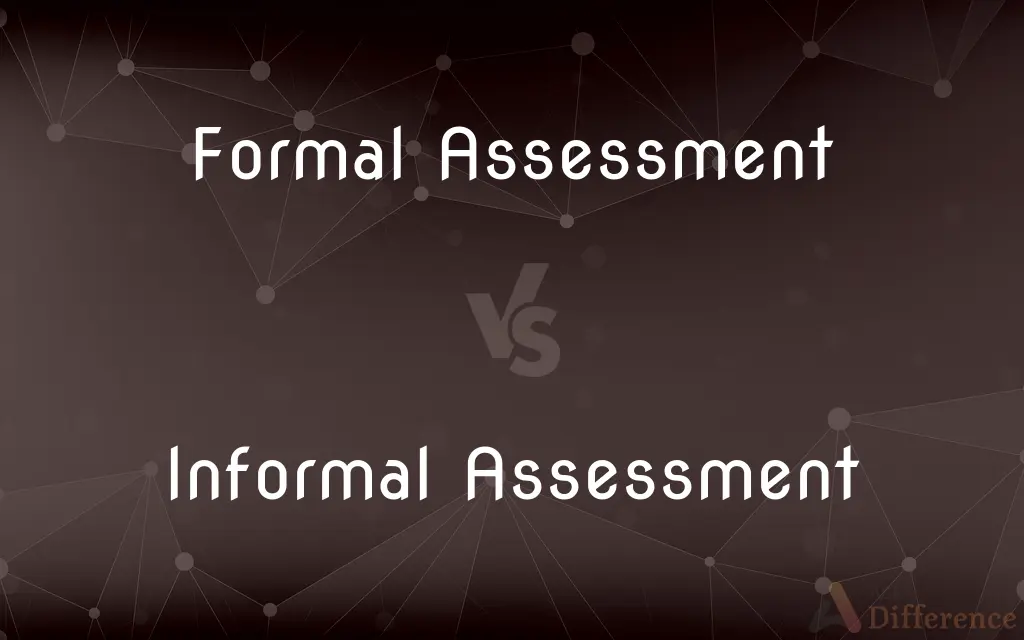Formal Assessment vs. Informal Assessment — What's the Difference?
By Urooj Arif & Maham Liaqat — Published on October 12, 2024
Formal assessments are structured, standardized tests measuring learning against set criteria, while informal assessments are flexible, observational tools for ongoing feedback.

Difference Between Formal Assessment and Informal Assessment
Table of Contents
ADVERTISEMENT
Key Differences
Formal assessments are characterized by their structured design, which often includes standardized tests with fixed questions and scoring criteria. These assessments aim to evaluate students' knowledge and skills against pre-established standards or benchmarks, making it possible to compare student performance across different contexts. On the other hand, informal assessments are less structured and can take various forms, such as observations, discussions, and ungraded assignments. They are primarily used to monitor student progress and provide immediate feedback to support learning.
While formal assessments typically occur at specific points during a course or program, serving as a summative evaluation of student learning, informal assessments are more fluid and can happen at any time. They act as formative evaluations, helping educators identify students' strengths, weaknesses, and misconceptions in real-time. Whereas formal assessments often contribute to final grades and can determine student advancement, informal assessments are more about guiding the learning process without necessarily affecting grades.
The preparation for formal assessments usually requires significant time and resources, as these assessments need to be carefully designed, validated, and standardized to ensure fairness and reliability. Conversely, informal assessments are more adaptable and can be created and implemented with minimal preparation, allowing teachers to respond to the needs of their students dynamically.
Feedback from formal assessments tends to be quantitative, providing scores or grades that summarize students' performance. In contrast, feedback from informal assessments is often qualitative, offering detailed insights into how students are learning and what they are struggling with. This qualitative feedback is crucial for supporting personalized learning paths and instructional adjustments.
One of the main advantages of formal assessments is their ability to provide objective measures of student learning, which can be essential for accountability purposes and for identifying broad educational trends. However, informal assessments offer a more nuanced understanding of student learning, capturing the complexities and subtleties of individual student progress that formal assessments might miss.
ADVERTISEMENT
Comparison Chart
Definition
Structured tests with standardized criteria.
Flexible, observational tools for feedback.
Purpose
Evaluate learning against standards.
Monitor progress and guide learning.
Timing
At specific intervals, often summative.
Ongoing, typically formative.
Preparation and Resources
Requires significant preparation and standardization.
Minimal preparation, highly adaptable.
Feedback Type
Quantitative (scores/grades).
Qualitative (detailed insights).
Impact on Grades
Often contributes to final grades.
Usually does not directly affect grades.
Role in Education
Summative evaluation for accountability.
Formative evaluation for personalized learning.
Compare with Definitions
Formal Assessment
Structured testing method with fixed criteria.
End-of-term exams assess cumulative knowledge.
Informal Assessment
Adaptable, ongoing evaluation methods.
Teacher observations inform daily instructional adjustments.
Formal Assessment
Utilizes standardized tests for objective measurement.
SAT scores are used for college admissions.
Informal Assessment
Emphasizes direct feedback and student engagement.
Thumbs up/down quick checks gauge understanding.
Formal Assessment
Often requires external validation or standardization.
State assessments ensure compliance with educational standards.
Informal Assessment
Aids in identifying individual strengths and weaknesses.
Portfolios showcase a student’s progress and areas for improvement.
Formal Assessment
Results are typically expressed in numerical scores or grades.
A student’s grade point average (GPA) reflects formal assessment outcomes.
Informal Assessment
Can be integrated into daily learning activities.
Exit tickets provide immediate insight into student comprehension.
Formal Assessment
Designed for comparative and evaluative purposes.
Benchmark assessments compare student performance to standards.
Informal Assessment
Focuses on qualitative insights into student learning.
One-on-one conferences reveal students' thought processes.
Common Curiosities
What is the main goal of formal assessments?
To objectively measure student learning against standardized criteria and benchmarks.
How do informal assessments benefit the learning process?
They provide immediate, personalized feedback, helping teachers and students adjust learning strategies as needed.
Can informal assessments be used to grade students?
Typically, they are used for formative purposes and not directly for grading, focusing on guiding rather than evaluating student performance.
What makes formal assessments reliable?
Their structured design, standardization, and validation processes ensure consistent and fair evaluation of student performance.
How do teachers use informal assessments in the classroom?
Teachers use them to observe students' learning processes, engage in interactive feedback, and adjust instruction based on real-time needs.
Why are formal assessments important in education?
They provide a standardized method for evaluating and comparing student achievement, often required for certification, advancement, and accountability.
What challenges are associated with formal assessments?
They can be resource-intensive to create and may not fully capture individual learning progress or creativity.
Can informal assessments guide curriculum development?
Yes, insights from informal assessments can inform curriculum adjustments to better meet student needs and learning styles.
Are informal assessments less important than formal ones?
No, they play a crucial role in the ongoing learning process, providing insights that formal assessments cannot.
How do formal and informal assessments complement each other?
Formal assessments provide summative evaluations of learning, while informal assessments offer ongoing, formative feedback, together supporting a comprehensive understanding of student achievement.
How do educators balance the use of both assessment types?
By aligning assessment strategies with learning objectives, educators can use both types to provide a holistic view of student learning.
Can the insights from informal assessments influence formal assessment strategies?
Yes, insights gained can lead to adjustments in teaching approaches and even the design of formal assessments to better align with student needs.
How does standardization affect the implementation of formal assessments?
It ensures fairness and comparability but can limit flexibility and the ability to measure complex cognitive skills and creativity.
What is a key difference in feedback between the two assessment types?
Formal assessments typically result in scores or grades, while informal assessments offer detailed, actionable feedback.
How can informal assessments be integrated into daily teaching?
Through techniques like observational notes, class discussions, and ungraded quizzes, allowing for flexible and immediate evaluation.
Share Your Discovery

Previous Comparison
Physical Weathering vs. Chemical Weathering
Next Comparison
Physiotherapy vs. Occupational TherapyAuthor Spotlight
Written by
Urooj ArifUrooj is a skilled content writer at Ask Difference, known for her exceptional ability to simplify complex topics into engaging and informative content. With a passion for research and a flair for clear, concise writing, she consistently delivers articles that resonate with our diverse audience.
Co-written by
Maham Liaqat












































